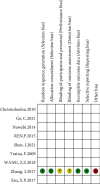Meta-analysis of the Efficacy of the Anatomical Center and High Hip Center Techniques in the Treatment of Adult Developmental Dysplasia of the Hip
- PMID: 36082152
- PMCID: PMC9448599
- DOI: 10.1155/2022/7256664
Meta-analysis of the Efficacy of the Anatomical Center and High Hip Center Techniques in the Treatment of Adult Developmental Dysplasia of the Hip
Abstract
Background: In total hip arthroplasty for the treatment of adult developmental dysplasia of the hip, there is considerable controversy regarding the placement of the acetabular cup, anatomic center, and upward in acetabular reconstruction. This article explores the efficacy of the anatomical center technique and high hip center technique in the treatment of adult developmental dysplasia of the hip.
Method: By searching for articles in the Cochrane Library, PubMed, CNKI, and Wanfang databases, we collected the literature on the treatment of adult developmental dysplasia of the hip by anatomical center and high hip center technology and screened the literature according to the inclusion and exclusion criteria. The Cochrane risk of bias assessment tool was used to assess the risk of bias of randomized controlled trials, the quality of the literature in retrospective cohort studies was assessed using the Newcastle-Ottawa scale, and the RevMan 5.4 software was used to analyze the extracted outcome indicators.
Results: Nine studies were finally included, including one prospective cohort study, eight retrospective cohort studies, two high-quality studies, and six moderate-quality studies. The meta-analysis results showed that the reconstruction of the acetabulum in two positions was significantly different in terms of operation time (WMD = -37, 95% CI: -45.25-28.74, P < 0.00001), intraoperative blood loss (WMD = -91.88, 95% CI: -108.57-75.19, P < 0.00001), postoperative drainage volume (WMD = 80.55, 95% CI: -140.56-301.66, P = 0.48), time to ground (WMD = -0.68, 95% CI: -1.37-0.0, P = 0.05), Harris score (WMD = -0.04, 95% CI: -0.91-0.82, P = 0.92), lower limb length difference (WMD = 0.21, 95% CI: -0.22-0.64, P = 0.33), WOMAC score (WMD = -1.24, 95% CI: -4.89-2.41, P = 0.51), postoperative complications (RD = -0.02, 95% CI: -0.06-0.02, P = 0.44), Trendelenburg sign (RD = -0.02, 95% CI: -0.02-0.05,P = 0.31), limb lengthening (WMD = 0.85, 95% CI: 0.61-1.09, P < 0.00001), prosthesis wear (WMD = 0.01, 95% CI: 0-0.02, P = 0.17), and prosthesis loosening (RD = 0.01, 95% CI: -0.02-0.04, P = 0.45).
Conclusions: The high hip center technique can reduce operative time, intraoperative blood loss, and downtime. The anatomical center technique is superior to the high hip center technique in terms of limb lengthening. Compared with acetabular anatomical reconstruction, there was no significant difference in postoperative drainage, lower limb length difference, postoperative complications, Trendelenburg sign, and prosthesis survival or wear. For DDH patients who are not severely shortened in the lower limbs and have severe acetabular bone defects, joint surgeons can choose to reconstruct the acetabulum in the upper part to simplify the operation, reduce the trauma of the patient, and accelerate the recovery of the patient, and they can choose to adjust the length of the neck and the angle of the neck shaft to maintain the moment arm of the abductor muscle. A ceramic interface or a highly cross-linked polyethylene interface minimizes the effect of hip response forces. To further evaluate the efficacy of the anatomical center technique and the high hip center technique in the treatment of adult developmental dysplasia of the hip, more large-sample, high-quality, long-term follow-up randomized controlled trials are still needed for verification.
Copyright © 2022 Chen Wu et al.
Conflict of interest statement
The authors declare that they have no conflicts of interest.
Figures















Similar articles
-
Does Cup Position at the High Hip Center or Anatomic Hip Center in THA for Developmental Dysplasia of the Hip Result in Better Harris Hip Scores and Revision Incidence? A Systematic Review.Clin Orthop Relat Res. 2021 May 1;479(5):1119-1130. doi: 10.1097/CORR.0000000000001618. Clin Orthop Relat Res. 2021. PMID: 33539054 Free PMC article.
-
[Effectiveness of proximal femur reconstruction combined with total hip arthroplasty for Crowe type Ⅳ developmental dysplasia of hip].Zhongguo Xiu Fu Chong Jian Wai Ke Za Zhi. 2020 Jun 15;34(6):683-688. doi: 10.7507/1002-1892.201911073. Zhongguo Xiu Fu Chong Jian Wai Ke Za Zhi. 2020. PMID: 32538556 Free PMC article. Chinese.
-
Integrated Acetabular Prosthesis Versus Bone Grafting in Total Hip Arthroplasty for Crowe Type II and III Hip Dysplasia: A Retrospective Case-Control Study.Orthop Surg. 2024 Oct;16(10):2401-2409. doi: 10.1111/os.14143. Epub 2024 Jul 23. Orthop Surg. 2024. PMID: 39043609 Free PMC article.
-
[Biomechanical research progress of common acetabular reconstruction techniques for Crowe type Ⅱ and Ⅲ developmental dysplasia of the hip].Zhongguo Xiu Fu Chong Jian Wai Ke Za Zhi. 2023 Mar 15;37(3):353-359. doi: 10.7507/1002-1892.202211052. Zhongguo Xiu Fu Chong Jian Wai Ke Za Zhi. 2023. PMID: 36940996 Free PMC article. Chinese.
-
[Advances in revision surgery after primary total hip arthroplasty for Crowe type Ⅳ developmental dysplasia of the hip].Zhongguo Xiu Fu Chong Jian Wai Ke Za Zhi. 2023 Dec 15;37(12):1548-1555. doi: 10.7507/1002-1892.202309016. Zhongguo Xiu Fu Chong Jian Wai Ke Za Zhi. 2023. PMID: 38130200 Free PMC article. Review. Chinese.
Cited by
-
Comparison of Cup Position and Perioperative Characteristics in Total Hip Arthroplasty Following Three Types of Pelvic Osteotomy.Medicina (Kaunas). 2025 Aug 2;61(8):1407. doi: 10.3390/medicina61081407. Medicina (Kaunas). 2025. PMID: 40870452 Free PMC article.
-
Medium- to long-term clinical efficacy of total hip arthroplasty with structural bone grafting for dysplasia of the hip.Int Orthop. 2024 Oct;48(10):2579-2588. doi: 10.1007/s00264-024-06199-0. Epub 2024 May 1. Int Orthop. 2024. PMID: 38691141 Review.
References
-
- Smith A. J., Dieppe P., Vernon K., Porter M., Blom A. W., National Joint Registry of England and Wales Failure rates of stemmed metal-on-metal hip replacements: analysis of data from the National Joint Registry of England and Wales. Lancet (London, England) . 2012;379(9822):1199–1204. doi: 10.1016/S0140-6736(12)60353-5. - DOI - PubMed
Publication types
MeSH terms
LinkOut - more resources
Full Text Sources
Medical
Research Materials
Miscellaneous

